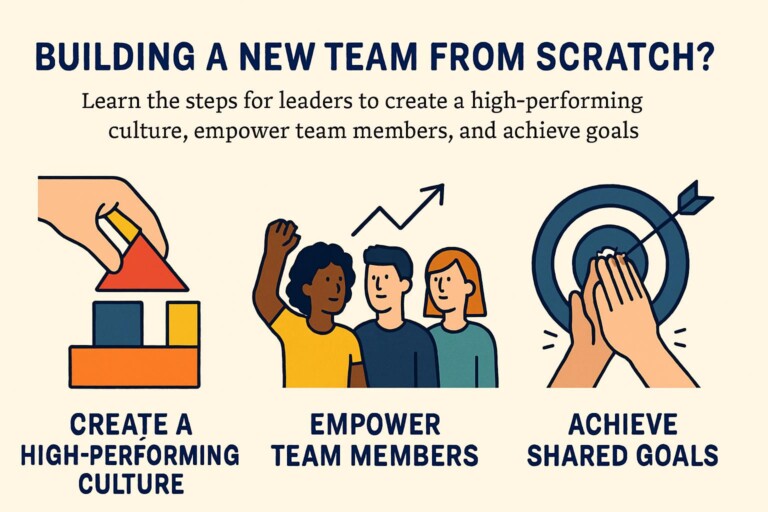Navigating the modern workplace is no walk in the park. One pressing issue? Toxic positivity. It’s the push to stay cheery, even when things are tough.
Sure, a positive attitude can help, but minimizing real problems? That can hurt everyone. Tackling this isn’t just a task for the higher-ups; it’s something every leader should be doing.
What is Toxic Positivity?
Toxic positivity is about forcing positive vibes and ignoring real struggles. Imagine a teammate brings up a problem. Someone chimes in with, “Just stay positive!” That’s not helpful; it invalidates genuine feelings and trust.
In the Air Force, we were taught resilience. It’s not just about being positive, but also about facing hard times head-on. A balanced workplace mixes positivity with reality.
Jump To Section
Recognizing Toxic Positivity in the Workplace
Understanding how to identify toxic positivity in your workplace is a crucial first step in fostering a healthier, more authentic environment. Let’s dive a bit deeper into recognizing these signs and why they matter.
Dismissing Negative Emotions
Imagine your team member expressing feeling overwhelmed by an upcoming deadline. If the response is, “It’s not that bad,” instead of addressing their concerns, you’re dismissing real emotions and experiences. This doesn’t solve the problem; in fact, it deepens it by making your team feel unseen and unheard.
In the Air Force, leaders are trained to pay close attention to their team members’ emotional states. Ignoring a pilot’s fear or an airman’s stress could jeopardize a mission. The same principle applies to the workplace: acknowledging and affirming emotions fosters trust.
Pressure to Be Happy
Creating an environment where employees feel they must be cheerful 24/7 can be detrimental. The implicit message is that only positive emotions are acceptable, which stifles genuine human interaction. When team members feel they can’t express their negative feelings, they become disengaged and less productive.
Leading with empathy means recognizing that each person has unique emotional experiences. Just like a commanding officer recognizes the value of a debrief session after a challenging mission, acknowledging highs and lows in the workplace is essential for real progress.
Ignoring Real Problems
Overlooking issues because they make people uncomfortable is a recipe for disaster. Think of an Air Force unit on an intense mission. If the leader’s sole focus is on keeping morale high but they ignore imminent threats, everyone is at risk. The same applies to the corporate environment.
When real problems are glossed over in favor of maintaining a positive facade, it creates a disconnect between leadership and the team. Addressing issues head-on, even if they are uncomfortable, builds resilience and trust. It’s about balancing optimism with realism—preparing your team for whatever challenges come their way.
The Impact of Toxic Positivity
Toxic positivity is more than just a nuisance; it can fundamentally undermine a team’s effectiveness and morale. Here are the key impacts:
- Worsened Mental Health:
- Ignoring genuine emotions leads to accumulated stress, anxiety, and even burnout.
- Comparable to a pilot managing operational stress, pressures become unsustainable if not addressed.
- Lost Trust in Leadership:
- Teams lose faith in leaders who overlook their real challenges.
- Leaders who consistently downplay concerns experience rapid erosion of credibility.
- Weak Team Dynamics:
- Suppressed genuine communication leads to misunderstandings and reduced innovation.
- Similar to a squadron hiding apprehensions, compromising overall mission effectiveness.
- Lower Employee Engagement and Morale:
- Superficial positivity undervalues employee contributions and struggles.
- For lasting morale, it’s crucial to acknowledge both challenges and victories.
- Increased Turnover Rates:
- Environments that ignore true emotions drive talent away.
- High turnover disrupts teams and harms long-term objectives.
- Unaddressed Problems Leading to Larger Issues:
- Ignoring issues in favor of positivity compounds small problems into larger failures.
- Similar to overlooking a crack in an aircraft’s fuselage, problems worsen without direct action.
By recognizing these impacts, leaders can foster an environment where authenticity and open communication thrive. Drawing from Air Force leadership principles, it’s evident that addressing both positive and negative emotions is essential for real progress. Let’s prioritize genuine, purpose-driven action and maintain the resilience needed for sustained success.
Tips for Combating Toxic Positivity in the Workplace
Toxic positivity isn’t just annoying. It’s counterproductive. It can stifle real communication and morale. Here are some straightforward tips to create a healthier, more authentic work environment.
1. Acknowledge Real Emotions
It’s crucial to recognize and validate your team’s genuine feelings. Don’t sweep concerns under the rug with empty reassurances. Instead, listen actively and show empathy. This is akin to a commander truly hearing out their squad, acknowledging stress, and addressing it head-on.
How To Achieve
- Hold Regular One-on-Ones: Set aside dedicated time to meet with team members individually. Ensure these sessions are a safe space for open and honest communication.
- Show Empathy and Understanding: Use active listening techniques. Acknowledge their feelings by repeating back what you’ve heard and validating their experiences.
- Model Vulnerability: Share your own experiences and challenges. This shows that it’s okay to be human and face difficulties.
2. Foster Open Communication
Create a culture where it’s safe to share thoughts and feelings. Encourage team members to speak up about their struggles without fear of judgment. Open, honest dialogue is the bedrock of strong, innovative teams whether in the cockpit or the boardroom.
How To Achieve
- Create Open Forums: Implement regular team meetings where everyone has an opportunity to speak freely. Encourage questions and feedback.
- Anonymous Feedback Channels: Provide a way for team members to share thoughts anonymously if they’re uncomfortable speaking up directly.
- Recognize and Reward Honesty: Publicly acknowledge and appreciate candid feedback and transparency. This encourages a culture of trust.
3. Balance Positivity with Reality
While positivity has its place, balance it with a realistic view of challenges. Encourage a forward-looking mindset that doesn’t ignore problems but seeks solutions. For instance, a mission briefing that acknowledges difficulties while outlining action plans fosters both morale and readiness.
How To Achieve
- Realistic Goal Setting: Ensure that goals are attainable and rooted in reality. Celebrate progress rather than perfection.
- Daily Briefings: Like military debriefs, use daily or weekly check-ins to assess real-time status and challenges. This keeps the team grounded and focused.
- Strategic Planning Sessions: Regularly revisit and revise strategies, considering both potential risks and opportunities.
4. Lead by Example
Show your team that it’s okay to express both positive and negative emotions. As a leader, your approach sets the tone. Share your own challenges and how you navigate them. Think of an Air Force leader who admits when they’re navigating a tough spot but demonstrates resilience and adaptability.
How To Achieve
- Share Personal Journeys: Regularly share your own challenges and how you’ve overcome them. This normalizes the experience of facing and overcoming difficulties.
- Be Present and Available: Make sure your team knows that you are there for them, not just as a leader but as a fellow team member.
- Transparent Decision-Making: Explain the rationale behind decisions, especially during tough times. It instills trust and clarity.
5. Celebrate Authentic Wins
Focus on real, meaningful achievements rather than vague, superficial praise. Highlight specific examples of team members overcoming obstacles and making genuine progress. This not only builds morale but also fosters a culture of authenticity and respect.
How To Achieve
- Highlight Specific Achievements: When recognizing accomplishments, be specific about what was achieved and why it matters.
- Team Recognition: Develop a system for peer-to-peer recognition, where team members can acknowledge each other’s contributions.
- Milestone Celebrations: Mark significant milestones with celebrations. It doesn’t have to be grand, but recognition is crucial.
6. Provide Resources for Well-being
Ensure your team has access to resources that support mental and emotional well-being. This might mean providing information about mental health services or implementing programs that promote work-life balance. Prioritize your people’s well-being much like the Air Force does with its comprehensive support programs for service members.
How To Achieve
- Employee Assistance Programs: Offer access to counseling services and stress management resources.
- Wellness Programs: Implement initiatives like flexible work hours, fitness programs, or mindfulness workshops.
- Encourage Breaks: Promote taking regular breaks to avoid burnout. Model this by taking breaks yourself.
7. Encourage Personal Growth
Empower individuals to pursue their own paths to improvement and resilience. Offer opportunities for professional development and personal growth. Encourage a mindset where every challenge is a chance to learn and grow. This builds a stronger, more adaptable team.
How To Achieve
- Professional Development Opportunities: Provide access to courses, workshops, and seminars.
- Mentorship Programs: Pair team members with mentors who can offer guidance and support in their professional journey.
- Personalized Development Plans: Work with individuals to create custom plans that align with their personal and professional goals.
8. Normalize Asking for Help
Encourage your team to seek assistance when needed. Normalize the act of asking for help to break down the stigma surrounding it. By showing that even leaders ask for support, you create a safer space for your team to do the same, fostering a culture of mutual aid and assurance.
How To Achieve
- Lead by Example: Don’t hesitate to ask for help yourself. It’ll show that seeking assistance isn’t a sign of weakness.
- Support Systems: Create a buddy system where team members can turn to each other for help and advice.
- Promote Counseling Services: Regularly remind your team about available counseling and support services, removing any stigma.
9. Practice Mindful Listening
Engage in mindful listening where you not only hear the words but understand the emotions behind them. Provide feedback that reflects an understanding of the speaker’s feelings. This deepens trust and ensures that communication is both effective and empathetic.
How To Achieve
- Active Listening Training: Conduct workshops to train your team in active listening techniques.
- Mindfulness Practices: Encourage mindfulness exercises, such as meditation, to help everyone engage more deeply during interactions.
- Feedback Mechanisms: Regularly seek and act on feedback about your listening skills from your team.
10. Set Realistic Expectations
Ensure that goals and expectations are realistic and attainable. Unrealistic deadlines and targets can perpetuate stress and anxiety, which toxic positivity might try to mask. Set clear, manageable objectives that allow room for genuine effort and achievement, promoting a healthier work environment.
How To Achieve
- SMART Goals: Ensure all goals are Specific, Measurable, Achievable, Relevant, and Time-bound.
- Regular Check-ins: Use these sessions to reassess goals and adjust them as necessary.
- Resource Allocation: Ensure that your team has the resources they need to meet set expectations without undue stress.
By implementing these strategies, you’re not just combating toxic positivity. You’re fostering an environment where your team can thrive authentically. Leadership, in any context, means prioritizing people and their unique journeys. Embrace each individual’s approach and strive to lead with genuine purpose and integrity.
Conclusion
Toxic positivity at work gets in the way of a real, supportive workplace. By spotting its signs and acting purposefully, we can foster authenticity and resilience. The goal isn’t to kill positivity but to balance it with reality.
Start now. Look at your work environment and have those tough talks. Lead with purpose. Your team deserves that.








